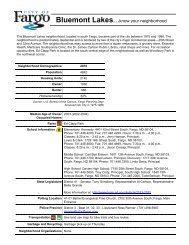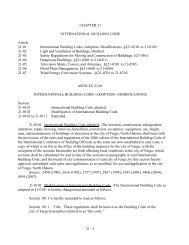Create successful ePaper yourself
Turn your PDF publications into a flip-book with our unique Google optimized e-Paper software.
a substantial amount <strong>of</strong> chloramines are being formed due to the reaction with thechlorine residual. This will cause the free chlorine residual to drop, therebydecreasing disinfection effectiveness, causing irritations to the eyes and mucousmembranes, and producing associated odors. This undesirable condition can beavoided to a great degree by routinely super-chlorinating. Super-chlorination is theprocess <strong>of</strong> quickly raising the free chlorine residual 5.0 to 10.0 ppm and then allowingthis higher residual to dissipate over night. Super-chlorination can be performed onan established schedule, for example, every two weeks or a test kit can be used todetermine when it is necessary. If testing <strong>of</strong> the pool water shows an appreciableamount <strong>of</strong> combined chlorine (the difference between the total and free residuals), 0.2ppm or more, then super-chlorination may be necessary. This method will be moreeconomical and accurate than an established schedule, but either will work.Chlorination, as the term implies, is the practice <strong>of</strong> introducing chlorine to pool water.Regardless <strong>of</strong> the product used or the method <strong>of</strong> application, the goal is to achieve achlorine residual possessing strong oxidizing and disinfecting properties. Chlorinemay be supplied as a gas, a solid, or a liquid, each having different handling andsafety conditions, but still providing chlorine for effective disinfection.4.2 CHLORINE GASChlorine gas is packaged under pressure as a liquid in metal cylinders and is fed into thesystem by a chlorinator, which regulates the amount <strong>of</strong> gas which; is introduced. Thecylinders are <strong>of</strong> seamless steel construction with an operating valve equipped with a safetydevice in the form <strong>of</strong> a fusible metal plug. These plugs are designed to melt at 158ºF topermit the escape <strong>of</strong> chlorine gas to prevent tank rupture. This fusible plug should not betampered with under any circumstances.The valve on the chlorine cylinder has a non-standard pipe thread requiring a special wrench.The use <strong>of</strong> these non-standard connections is intended to discourage anyone from usingpliers, wrenches, or hammers to force connections or otherwise depart from standardhandling techniques. If you do not presently have one <strong>of</strong> these special wrenches, pleaseobtain one from your chlorine supplier. The wrench must remain on the valves in use at alltimes.Always use a new lead washer when connecting a chlorine cylinder to the chlorinator. Openthe valve only one-quarter to one-half turn after connecting the chlorinator and check theconnection for the presence <strong>of</strong> leads. This may be accomplished by holding a swabmoistened in ammonia near all the connections. The presence <strong>of</strong> chlorine gas will beindicated by the formation <strong>of</strong> a white smoke-like cloud <strong>of</strong> ammonium chloride. Do not forcethe chlorine cylinder valve if it is difficult to open. Damage to the valve may occur, causinga major chlorine leak. Return the cylinder to the supplier rather than risk the danger <strong>of</strong> a leakcaused by a broken valve.The quantity <strong>of</strong> gas in a chlorine cylinder can be determined only by weighing the cylinderon a platform scale. When a new cylinder is connected to the chlorinator, its weight should12












